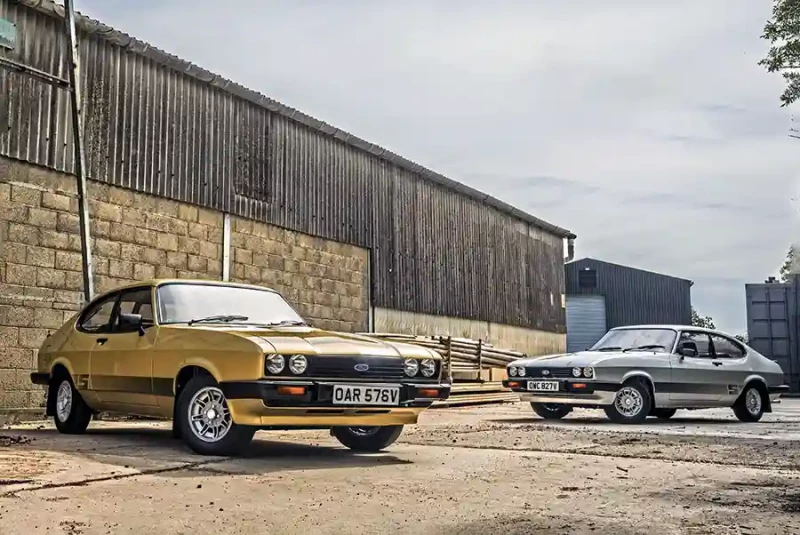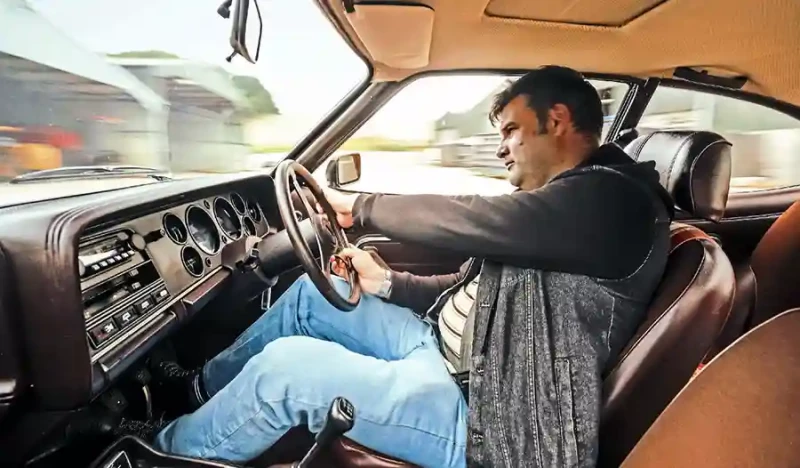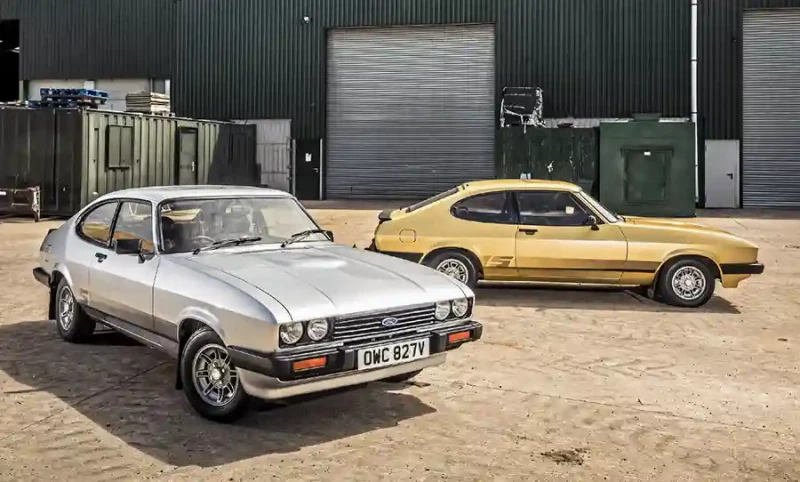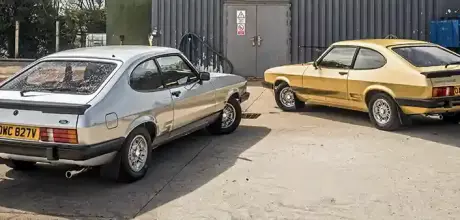On the hunt for criminals in Bodie & Doyle’s 1980 Ford Capri 3.0S
These Ford Capri 3.0Ss were the cars driven by Bodie and Doyle in a bunch of 1980-filmed episodes of cult TV show The Professionals. We drive both – cardboard boxes beware.
Words SAM DAWSON
Photography TONY BAKER
On the hunt for criminals in Bodie & Doyle’s Ford Capri 3.0Ss
THE PROFESSIONALS
‘Everything about these cars seems perfectly set up for action’
Professional Misconduct Kicking up dust in Bodie & Doyle’s Ford Capri 3.0Ss.
PLUS meet Sergeant Geoff Roberts, real-life Capri-driving Eighties crimefighter

This is a surreal experience. I’m driving around the environs of a dusty industrial farm hidden away in the Warwickshire countryside. Ahead of me is a pile of rubble, a brick hut bearing faded signs warning of dangerous chemicals, and a hastily parked gold MkIII Ford Capri 3.0S. And I’m viewing it all down the bonnet of a silver counterpart.
‘THE CULTURAL INFLUENCE IS MORE LASTING THAN IT EVER SEEMED BACK WHEN THESE CAPRIS WERE NEW’
Were this an episode of The Professionals, there would no doubt be terrorists holed up in the hut, threatening to set off some device that’ll irradiate Neasden unless their demands are met. Probably something involving a big bag of cash, a crate full of machine guns, a wayward heiress with Marxist guerrilla entanglements and a plane fully fuelled-up and ready to leave some little-used airfield in Hertfordshire.

But these aren’t lookalikes. They’re the real things. The silver car was driven by Lewis Collins as William Bodie in the fourth filmed series of The Professionals. The gold car parked up ahead was that of Martin Shaw’s Ray Doyle. And they’ve just been sold as a pair by Iconic Auctioneers for a record-breaking £186,000. Seasoned fans of The Professionals will already have raised quizzical eyebrows at the numberplates. They look familiar, but didn’t the cars in the series have W-suffixes? Well, yes and no. These Capris were supplied by Ford to Mark 1 Productions in June 1980 registered as you see here, OWC 827V and OAR 576V. However, knowing that the episodes would be screened later in the year after the August new-model change, Ford press officer Barry Reynolds supplied them with W-suffix plates, taken from Ford’s future allocation, for a more contemporary look.

‘WHEN THE GOLD CAR WAS RESTORED, THE ORIGINAL ACCIDENT DAMAGE FROM “KICKBACK” WAS FOUND UNDER SWATHES OF FILLER’
Ironically, thanks to the way The Professionals was transmitted, this needn’t have mattered much given that from 1979’s Series Three onwards each ‘series’ was cobbled together from episodes which in some cases were actually shot two years earlier. Ostensibly these are the Series Four Capris, but their appearances are interspersed with those from the similar-looking COO 251T/UOO 303T as well as Doyle’s Escort RS2000. These cars appear in the final televised fifth series too, shown in 1983, the same continuity reasons causing them to alternate again with the similar-looking VHK 11W and 12W.
It all sounds chaotic, but it makes more sense when watching The Professionals back today. Although Series One infamously featured British Leyland-supplied cars often subject to continuity issues because BL kept taking them back for press duties, it was explained by Gordon Jackson in the episode ‘Close Quarters’ that these Capris came from CI5’s carpool.
That’s Criminal Intelligence Five to the uninitiated. Although the series was originally intended as a sort-of British Starsky & Hutch, focusing on the relationship between a mismatched pair of special-ops police officers, it morphed into something much more unique, gritty and dark. It was the brainchild of Avengers co-creator Brian Clemens, and CI5 was a fictional government agency that blended the plainclothes policing of the CID with the sometimes lethal espionage tactics of MI5. The result was a macho, violent series which received a critical drubbing in the papers, but was enjoyed by millions. Watching it today, it’s far from the cringeworthily dated flimflam it’s often made out to be.
It holds a brutal mirror up to late Seventies and early Eighties Britain in all its angry, run-down, socially-polarised drabness. Its characters are world-weary and morally ambivalent. It’s far more nuanced than you might remember.
And no doubt it helped Ford shift more Capris – tellingly, when Ford discontinued lhd Capris in 1984 in favour of the XR4i, the older car was kept in production in right-hand drive form for another two years, such was the demand from British drivers no doubt with the exploits of Bodie and Doyle fresh in their minds.
This pair of cars was actually introduced with a joke, although the out-of-sequence way in which the episodes were shown left it lost on the viewers. In the early scenes of ‘The Gun’ – an otherwise grim tale of a pair of teenagers discovering a criminal’s discarded weapon, with tragic consequences – Bodie drives through London streets as Doyle shaves with an electric cordless razor in the passenger seat of this silver car. ‘How come we always end up in my motor?’ Bodie asks, mocking his partner who apparently got drunk a few nights earlier and forgot where he parked the RS2000, which in real life had been taken back by Ford by that point. Our gold car appears for the first time later in the episode as Doyle’s new wheels.
‘I FIND MYSELF HANGING ON TO THE STEERING WHEEL IN TIGHT CORNERS, LESS IN CONTROL BUT FEELING ALTOGETHER MORE DRAMATIC’
These cars should drive identically, given that they’re both 1980 3.0Ss restored to as-new condition. Even their interiors look largely the same, combining Seventies plaid with brown vinyl. However, they sport different seats. Bodie’s car has the standard wide-squabbed design, whereas Doyle’s features Custom-pack Recaro buckets with the famous ‘fishnet’ headrests. Given the demands of filming, it’s amusing watching episodes like ‘Blood Sports’ (with its appearances by then-unknown Pierce Brosnan and Ruby Wax) and seeing those headrests disappear whenever in-car camerawork is needed.
In Doyle’s Recaro-equipped Capri, I feel secured, confident to hurl the car around a bit and take advantage of that taut S-specification suspension. In Bodie’s silver car, although I sit lower and closer to the centre of gravity, I find myself hanging on to the steering wheel in tight corners, less in control but feeling altogether more dramatic and cinematic.
The auto-choked ‘Essex’ V6s fire easily enough when accompanied with a prod of the throttle, waffling into life and settling to a gruff, growling idle. It’s easy to mis-slot the gear lever into third and stall when pulling away as a result – not very… Professional. Interestingly, both Collins and Shaw were taught some basic stunt-driving manoeuvres, especially handbraketurn slides to a halt. It was tricky to convincingly swap between stunt double and actor when getting out of the cars.
The cars led hard lives on set – Martin Shaw recalled they spent a lot of time in second gear, bouncing off rev limiters. Just three months into its stint, Doyle’s was badly damaged during the filming of ‘Kickback’, stunt driver Frank Henson squealing around the then-deserted and derelict Royal Agricultural Hall in Islington while chasing some Triumph TC-driving terrorists before ploughing into that Professionals cliché, a wall of cardboard boxes. Tellingly, there comes a point in the scene where the gold Capri is only shot from the A-pillars back. Filming ‘The Untouchables’ in December 1980, it rolled into the back of the silver car during the setup for an escape scene. Whether the doctor who bought it after filming finished was aware of all these scrapes is unknown. When the car was restored in the Nineties, the damage from ‘Kickback’ was found under swathes of filler.
‘COLLINS AND SHAW WERE TAUGHT SOME BASIC STUNT-DRIVING MANOEUVRES, ESPECIALLY HANDBRAKE-TURN SLIDES TO A HALT’
So long as you’re deliberate about selecting first, the four-speed manual soon reveals itself to be a slick device for a wieldy car. Both are equipped with the rare optional power steering, making the twirl through the 2.5-turns lock-to-lock easy. Everything in these cars – especially the Recaro-equipped gold one – seems perfectly laid out for knockabout driving action. It’s all aided by the low-down torque of the V6. It may only be a 3.0-litre, but in the 1116kg Capri it has the urge of an American small-block muscle car. It’s controlled off the line, the rear 185/70 SR13 Goodyears only squealing when the live rear axle is forced to negotiate tight turns on tarmac – as it so often was. In 1980, the Capri made sense in the context of crimefighting.
Rather than quirky props chosen to match the characters who drove them, the Capri blended seamlessly into British life. Older examples were snapped up by boy-racers on shoestring budgets; new ones were bought by businessmen for the commute. They were a regular fixture on the UK top-ten bestseller chart. But most importantly, the police used them in real life.
This sense of gritty reality was increasingly to be found on British TV and film as the Seventies became the Eighties. This was the Britain of The Long Good Friday, Boys From The Blackstuff and Threads. The era of goofy sound effects, daft set pieces and double-entendres that summed up much of Roger Moore’s career from The Saint to Bond via The Persuaders was dying. Lightweight escapism had lost its lustre in the midst of Airey Neave’s assassination, the Iran-Iraq War and the Embassy Siege. The Professionals’ early budget also made it seem shockingly real at times too – often unable to shoot in central London where it was nominally set, the producers often decamped to quiet corners of the Home Counties, where prop weapons occasionally alarmed curtain-twitching onlookers, and the real police called to investigate the ersatz officers.
By the time Bodie and Doyle first got into these Capris, the show itself was changing too. Early series have a markedly bigoted undertone at times. However by Series Four, Britain had a female Prime Minister in Margaret Thatcher, and the female roles in the series migrated away from damsels-in-distress types and towards positions of authority.
In ‘Wild Justice’, the first televised episode where these cars appear, Sarah Douglas’s psychologist character demonstrates how ex-SAS hard-man Bodie was putting CI5 operations in danger with his fists-first, loose-cannon attitude. Doyle was always the more progressive of the pair, and by Series Four he’d become the archetypal early-Eighties yuppie urbanite, immersing himself in Japanese philosophy, practicing Kendo and living in a slick apartment full of high-end hi-fi equipment. In earlier series he was a hard-drinking womaniser mocked for owning, of all things, a second-hand Jaguar E-type. By the later series Shaw – who picked his own wardrobe – was combining white suit jackets with pastel T-shirts in a style Don Johnson would make his own a few years later over in Florida.
And yet, with no episodes filmed after 1981 despite being screened into 1983, The Professionals dated rapidly. The neondrenched, electronically-soundtracked influence of Scarface and Miami Vice were imminent. Bodie and Doyle were left frozen in an era of Seventies-overhang fashion, urban decay, and a peripheral association with a football-hooligan, pub-fight hard-man culture despised by the late Eighties. One that briefly dragged the Capri down with it. It comes as no surprise to learn that both of these cars were stolen by thugs – the gold car ramraided a tobacconists in 1988 and the silver one was joyridden and torched a year later – but escaped the crusher long enough to be rescued by enthusiasts for their cult classic appeal.
But look beyond the aesthetics, and The Professionals’ longer-term influence has been far more positive. Viewers aren’t squeamish about being confronted by the realities of crimefighting anymore. Every era since has had similar series – Spender, Backup, In Deep, Spooks, Luther, and more recently Line Of Duty and Blue Lights all seem to owe something to its amorality and darkness. Fans of the series – presumably including the new owner of these cars – know that its cultural influence is far more lasting than it ever seemed back when they were new. These aren’t just Capris, they’re artefacts.
Thanks to: iconicauctioneers.com, Bob Rocca
Mint now, full of filler in the Eighties. This car suffered extensive damage on set Recaros are a better place for driving action. Hold on tight! Seats don’t offer much support. This pair set a price record for MkIII Capris.
Handling is neat and wieldy for a live-axled car As ’70s as a pair of checked turnup trousers. Essex V6 delivers musclecar punch.
TECHNICAL DATA 1980 Ford Capri 3.0S
- Engine 2994cc V6, ohv, Weber 38DGAS carburettor
- Max Power 138bhp @ 5000rpm
- Max Torque 174lb ft @ 3000rpm
- Transmission Four-speed manual, rear-wheel drive
- Steering Power-assisted rack and pinion
- Suspension Front: independent, MacPherson struts, coil springs, telescopic dampers, anti-roll bar. Rear: live axle, leaf springs, telescopic dampers, anti-roll bar
- Brakes Discs front, drums rear, servo-assisted
- Performance Top Speed: 123mph
- Acceleration 0-60mph: 8.6sec
- Weight 1116kg
- Fuel consumption 25mpg
- Cost new £6147
- Value now £93,000
Ford changed identities so cars looked new


